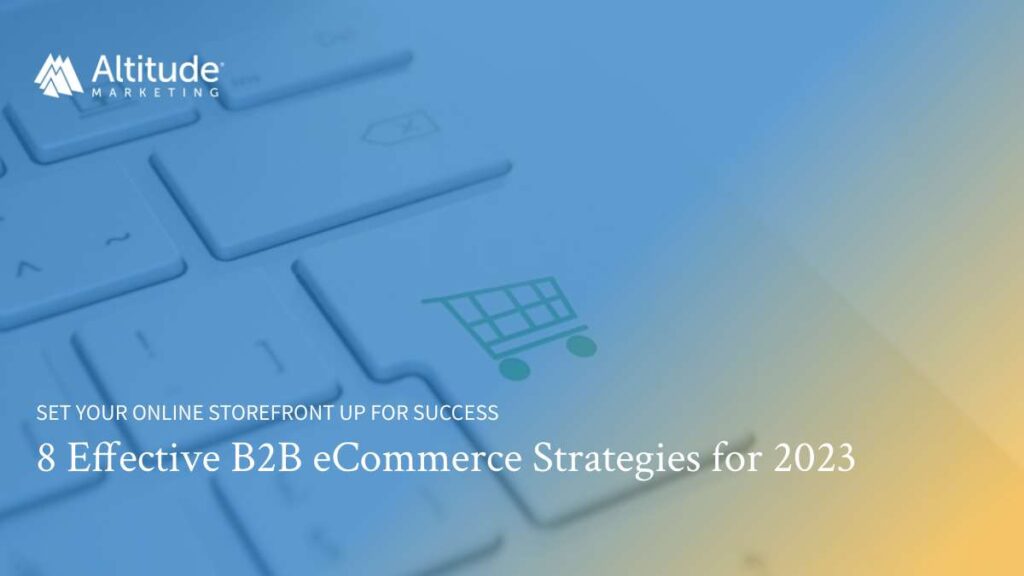B2B eCommerce is booming. By 2023, global eCommerce sales are expected to reach $6.2 trillion. That’s nearly double its market size from 2019.
Remember those lockdowns from the COVID pandemic’s early days? That’s likely when more and more people became comfortable with online shopping.
In other words: Thanks, COVID.
Regardless, B2B eCommerce is likely here to stay.
As a result, you’ll want to know: What are the best ways to tap into this surging market? How can you take an existing B2B eCommerce model from good to great? What B2B eCommerce best practices can you expect in 2023 and beyond?
Below, we’ll address those questions – and more.
First up, however, let’s define a couple terms. (We hope it goes without saying: Skip the next paragraph if you’re already fluent in the language of eCommerce.)
When we’re talking about business-to-business (B2B) electronic commerce (aka eCommerce), we’re talking about goods and services sold via online transactions. In other words, your customers place their orders digitally – and not in person or by phone.
With ☝out of the way, let’s get into the B2B eCommerce strategies that work best. Below you’ll find the top eight approaches for successful B2B eCommerce.
- Provide comprehensive product details
- Enhance your website’s functionality
- Offer a customizable buying experience
- Optimize pay-per-click advertising
- Deliver quality customer service
- Market on social media platforms
- Leverage social proof
- Partner with a B2B marketing agency

The Best 8 B2B eCommerce Strategies for 2023
1. Provide Comprehensive Product Details
As you might expect, customers weigh all the pros and cons before hitting a buy button. Usually, several people are involved in the final decision. It’s no wonder 77 percent of B2B customers say their latest purchase was very complex or difficult.
So, how can you increase the likelihood that customers choose you over the competition? In short: Make the customer’s buying decision easier.
That means, your website should include product and services pages that answer every conceivable question a buyer may have, in an easy-to-skim format. This saves the buyer time and speeds the decision-making process.
(Related: Best B2B Website Practices for 2023)
2. Enhance Your Website’s Functionality
Here’s a mistake: Designing your website based only on how it appears on a desktop computer.
For one, many of your customers will access your site with a phone, not a desktop computer. On top of that, Google uses mobile-first indexing. That means, Google’s bots will preferentially crawl the mobile version of your website – and not the desktop version – for indexing and ranking.
So, if you’ve only optimized your site for desktop, you’ll likely frustrate potential customers as well as fail to rank high in Google search.
That’s why it’s essential to optimize your website for all devices. Luckily, Google offers two tools for checking your website’s performance.
- Lighthouse audits your website’s pages to see if they’re optimized for mobile.
- Pagespeed Insights checks your website’s speed across all devices and diagnoses performance issues.
(Related: B2B SEO Tips That Work)
3. Offer a Customizable Buying Experience
Not all customers are the same. To cast a wide net, you’ll want to accommodate as many buyers’ needs as possible.
One way to do this: offer a scalable pricing model. Let’s say you’re selling software. You might include three pricing tiers. The least expensive product subscription might include fewer features. Or it might allow for fewer users than the others.
4. Optimize Pay-Per-Click Advertising
Pay-per-click (PPC) advertising is a type of digital advertising where you pay search engines (like Google) every time someone clicks on your ad.
(By the way, if someone just looks at your ad – but doesn’t click – you don’t pay anything.)
These ads allow you to target specific users based on their location, hobbies, and more. To optimize your PPC campaigns:
- Add negative keywords. Let’s say you don’t offer free trials. You might add “free” to your negative keyword list. That way your ad won’t show up when someone’s search contains the word “free.”
- Leverage ad extensions. They provide sitelinks to different pages on your website as well as callouts for benefits like free shipping or 24/7 customer service.
(Learn more: Everything You need to Know About Search Advertising)
5. Deliver Quality Customer Service
When it comes to B2B eCommerce, exceptional customer service is key. You want your clients to have a fulfilling experience from the moment they learn about your company to long after you make the sale.
By answering customer questions and solving their problems, you’ll keep customers happy, which makes them more likely to refer your business to others.
To satisfy the needs of all of your customers, offer multiple ways for buyers to interact with your company, including:
- Phone
- Live chat
- Help center
- Social media
6. Market on Social Media Platforms
Social media is a powerful tool for B2B eCommerce companies. In fact, it’s the third most critical marketing tactic for B2B businesses (just behind email newsletters and blogs). Use it to capture and promote comments from happy clients, answer customer questions, share product updates, offer helpful information, and talk about your company’s mission and culture.
Top social media platforms for B2B eCommerce include:
7. Leverage Social Proof
Client testimonials communicate to potential customers, “This company is legit.” So consider including a review widget on your website.
8. Partner With a B2B Marketing Agency
To keep up with all these B2B eCommerce strategies, team up with a B2B marketing agency that understands what it’s like to market to the audiences you’re looking to reach. These agencies know how to create B2B marketing campaigns that get results.
Ideally, the agency will staff a team of website developers, digital marketers, graphic designers, writers, and social media specialists. This frees you up to focus on your unique strengths – and will likely help you to generate even more sales.
Conclusion: Best Practices Give You an Edge
An increasing number of companies are leveraging B2B eCommerce for 2023 and beyond. To take your B2B eCommerce business to the next level, you’ll want to master the latest best practices. By improving your website’s information and functionality, enhancing your PPC advertising, offering world-class customer service, leveraging social media, and teaming up with a B2B marketing agency, you’ll grow your sales.



